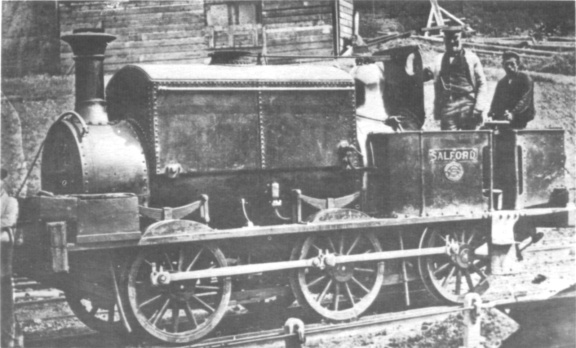
| THE INDUSTRIAL RAILWAY RECORD |
© JUNE 1966 |
“
THE BUILDER” - 1874D. COLE
One has to seek information on contractors’ locomotives from the most recondite sources, and so, having to consult the 1874 volume of "The Builder" for quite other purposes, it seemed worth while checking the advertisements with this in mind. Sure enough, the exercise was by no means unproductive.
The 3rd January issue contains a notice of contractors’ plant for sale at Hammersmith belonging to Francis Rummens, and including parts of a four-coupled locomotive: nothing much to go on here, but 24th January was more worth while. Fuller, Horsey, Sons & Co. announced a sale by auction on 23rd and 24th February of the plant used by the contractors, Crampton & Sons, on the East and West Junction Railway, which was lying at various places between Byfield and Stratford; it included a standard gauge Manning Wardle six-coupled saddle tank locomotive with 11in by 20in inside cylinders, and three four-coupled saddle tanks with outside cylinders 10in by 20in and 12in by 20in, by Neilson, and "Hawthorne & Co". On 18th April is advertised a standard gauge Manning Wardle six-coupled saddle tank with 11in by 17in cylinders, named KINETON, used on the construction of the East & West Junction Railway and, in spite of the discrepancy in dimensions, presumably the subject of the previous notice; perhaps Manning Wardle 177 of 1866, whose ultimate fate seems unknown. Its sister, Manning Wardle 178, had in 1871 become E&WJR 1 and was later MOROUS on the Hundred of Manhood and Selsey Tramway, where it lasted until 1935. The two Neilson engines may well have been 1633 of 1871 and 1703 of 1872, both 0−4−0 saddle tanks; the latter became KILMARNOCK of S. Thomas.
An advertisement in the 27th June issue lists equipment for disposal that had been previously used by the late John Jay in widening the North London Railway, but no locomotives are included. On 4th July is announced the auction, on 11th August, of the plant used by T. & C. Walker in building the Somerset & Dorset Railway extension to Bath. This included four six-coupled standard gauge inside cylinder saddle tanks of which two were by Manning Wardle and one by the Worcester Engine Company; also a six-coupled outside cylinder saddle tank by Fox Walker, and one four-coupled inside cylinder locomotive by Appleby Bros. The latter firm advertised from an address in Emerson St., Southwark, London, but they are believed to have immediately sub-contracted any orders (to Bagnall, and to Fox Walker, for instance). None of these engines seems to be identifiable, although a study of the Worcester Engine Company list suggests that their contribution was one of the first five built by the firm, around 1865. "T. Walker" was no doubt T. A. Walker of Manchester Ship Canal fame, and this S. & D. job a hitherto unsuspected contract.
A six-coupled tank locomotive used by Furniss & Buxton on the construction of the Minehead & Watchet Railway, a broad gauge line worked by the Bristol & Exeter, was advertised for sale in the 1st August issue. "Furniss" is doubtless George Furniss of Northern Outfall (London) and Thames Embankment fame. Finally the issue of 19th September gives notice of the sale, on 15th October, of the plant used by Philip Stiff (who seems otherwise unrecorded as a Railway contractor) in building the Hythe to Sandgate branch of the South Eastern Railway. This included a six-coupled 11in standard gauge tank by Manning Wardle and a four-coupled 9in tank by Rowland Brotherhood. Again, neither can be identified from these meagre particulars, but perhaps there is other recorded information which will help us to piece together these fragments of history. Further comments will be most welcome.

An old Manning Wardle memo-book, which has successfully survived three removals, records that on 27-6-1893 the Fryston Coal Company (Yorkshire) ordered a "Loco Boiler for 11˝ x 18 Worcester Eng Co make". Unfortunately, no further details are given. Locomotives built by the Worcester Engine Company were extremely rare in industrial use, and further information on the firm‘s products would be welcomed. The accompanying photograph, from the collection of Frank Jones, shows one such locomotive on T. A. Walker’s Manchester Ship Canal contract. Perhaps SALFORD is in some way connected with the locomotive of similar parentage mentioned in the article above?